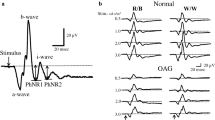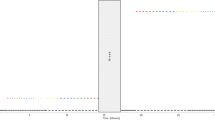Abstract
Eighteen patients with early maculopathies of various etiologies were tested with pattern and focal electroretinograms (macular ERGs), with high (400 cd/M2) and moderate (40 cd/M2) stimulus intensities and a four-alternative forced choice (4AFC) contrast sensitivity test in addition to intensive clinical examinations.
High spatial frequency contrast sensitivity loss on the 4AFC test was the most striking and consistent feature of all cases. The only eyes not outside normal contrast sensitivity limits were three in which diagnosis was uncertain and the patients had not recognized any problem, including two marginal solar burns. Maculopathy also substantially reduced macular ERG amplitides. Criterion scores on these tests separated patients from normals more effectively than other noninvasive procedures and only missed one eye detected by contrast sensitivity. Latencies were affected but the delays were of no clinical significance in the individual case. Stimulus intensity was not critical.
The results indicate that contrast sensitivity testing and macular ERGs are very reliable indices of central visual dysfunction at a stage when visible macular changes are too subtle for confident diagnosis. Contrast sensitivity has appeal because of its reliability, objectivity, simplicity, and noninvasive nature. It is equally applicable to children and adults. Pattern and focal ERGs can establish that the visual deficit has a retinal origin and can provide the most reliable objective confirmation.
Similar content being viewed by others
References
Arden GB and Bankes JLK (1966) Foveal electroretinogram as a clinical test. Br J Ophthalmol 50:740
Arden GB, Carter RM, Hogg CR, Powell DJ and Vaegan (1980) Reduced pattern electroretinograms suggest a preganglionic basis for nontreatable human amblyopia. J Physiol 308:82P-83P
Arden GB, Carter RM and MacFarlan A (1984) Pattern and ganzfeld electroretinograms in macular disease. Br J Ophthalmol 68:878–884
Arden GB and Jacobson SJ (1978) A simple grating test of contrast sensitivity. Preliminary results indicate value in screening for glaucoma. Invest Ophthalmol Vis Sci 17:219–223
Arden GB and Vaegan (1983) Electroretinograms evoked in man by local uniform or patterned stimulation. J Physiol 341:85–104
Arden GB, Vaegan and Hogg CR (1982) Clinical and experimental evidence that the pattern ERG (PERG) is generated in more proximal retinal layers than the focal ERG (FERG). Trans NY Acad Sci 388:580–601
Biersdorf W and Diller DA (1969) Local electroretinograms in macular degeneration Am J Ophthaolmol 68:269–303
Brindley GS and Westheimer G (1965) Spatial properties of the human electroretinogram. J Physiol 179:518–537
Campbell FW and Green DG (1965) Optical and retinal factors affecting visual resolution. J Physiol 181:576–593
Hess RF and Baker CL (1984) Human pattern-evoked electroretinogram. J Neurophysiol 51:939–951
Hess RF and Howell E (1977) The threshold contrast sensitivity function in strabismic amblyopia: Evidence for a two-type classification. Vision Res 17:1049–1055
Hess RF and Woo G (1978) Vision through cataracts. Invest Ophthalmol Vis Sci 17: 428–435
Holden AL and Vaegan (1983) Comparison of the electroretinogram and the pattern electroretinogram in the pigeon. J Physiol 344:11–23
Jacobson SJ, Sandberg MA, Effron MH and Berson EL (1979) Foveal cone electroretinograms in strabismic amblyopia. A comparison with juvenile macular degeneration, macular scars and optic atrophy. Trans Ophthalmol Soc UK 99:353–356
Korth M (1983) Pattern-evoked responses and luminance-evoked responses in the human electroretinogram. J Physiol 337:451–469
Lawwill T (1984) The bar pattern electroretinogram. Doc Ophthalmol Proc Ser 40:1–10
Maffei L and Fiorentini A (1981) Electroretinographic responses to alternating gratings before and after section of the optic nerve. Science 211:953–955
Maffei L and Fiorentini A (1982) Electroretinographic responses to alternating gratings in the cat. Exp Brain Res 48:327–334
Riemslag FCC, Ringo JL, Spekreijse H and Verduyn-Lunel H (1985) The luminance origin of the pattern electroretinogram in man. J Physiol 363:191–209
Sandberg MA, Jacobson SG and Berson EL (1980) Foveal cone electroretinograms in retinitis pigmentosa and juvenile macular dystrophy. Am J Ophthalmol 88:702–707
Spekreijse H, Estevez O and van der Tweel LH (1973) Luminance responses to pattern reversal. Doc Ophthalmol Proc Ser 2:205–211
Vaegan (1981) Pigeon pattern electroretinograms differ from focal electroretinograms. J Physiol 319, 75P
Vaegan (1984) An improved method of constructing pattern electroretinogram electrodes. Doc Ophthalmol Proc Ser 40:287–292
Vaegan, Arden GB and Hogg CR (1982) Properties of normal electroretinograms evoked by patterned stimuli in man. Doc Ophthalmol Proc Ser 31:111–128
Vaegan and Billson FA (in press) The differential effect of optic nerve disease on pattern and focal electroretinograms. Doc Ophthalmologica
Vaegan, Billson FA, Kemp S, Morgan M and Donnelley M (1984) Macular electroretinograms: Their accuracy, specificity and implementation for clinical use. Aust J Ophthalmol 12:359–372
Vaegan and Halliday BL (1982) A forced choice test improves clinical contrast sensitivity testing. Br J Ophthalmol 66:477–491
Author information
Authors and Affiliations
Rights and permissions
About this article
Cite this article
Vaegan, Billson, F.A. Macular electroretinograms and contrast sensitivity as sensitive detectors of early maculopathy. Doc Ophthalmol 63, 399–406 (1986). https://doi.org/10.1007/BF00220232
Issue Date:
DOI: https://doi.org/10.1007/BF00220232




